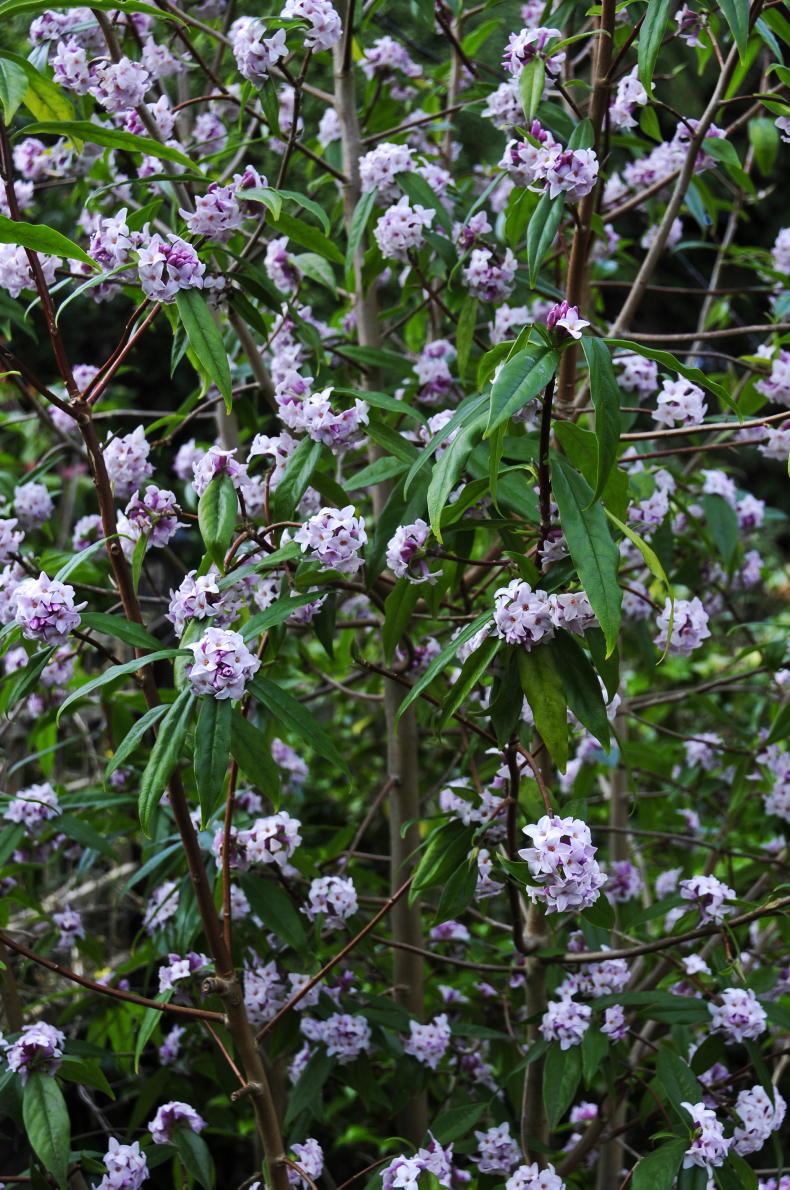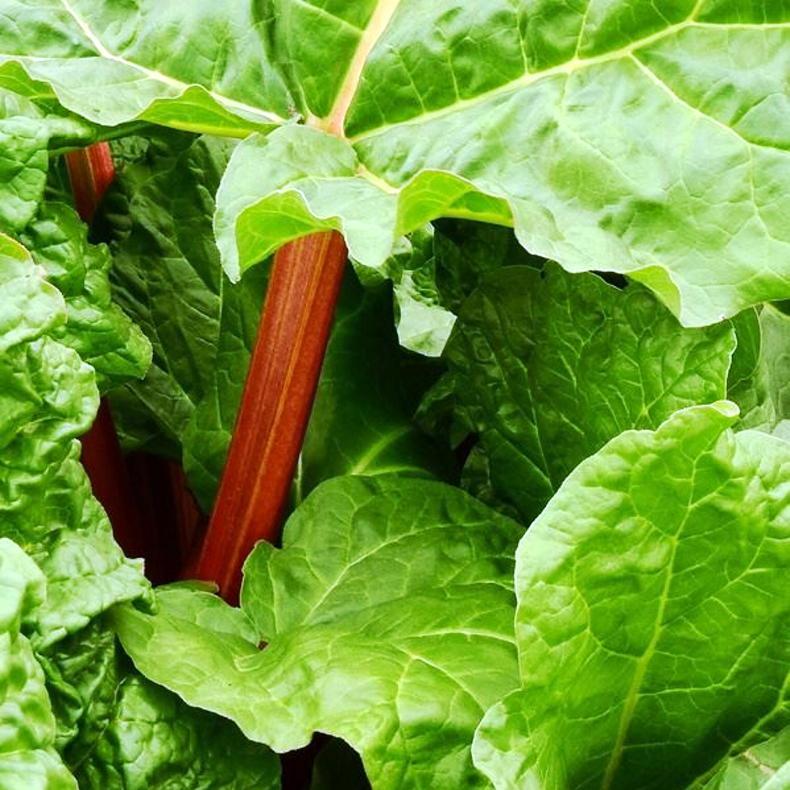Name: Himalayan daphne
Botanical name: Daphne
Family name: Thymelaeaceae, the Daphne family is really only represented outside of tropical areas of the globe by Daphne itself. Renowned for sweet scent, the old favourite mezereon, Daphne mezereum, was popular in cottage gardens decades ago as it was easy to grow from seeds. Seedlings often pop up in the vicinity of the parent bush and these were passed on to neighbours and friends. It flowers in February with light purple fragrant flowers of flaring tubular shape clustered along bare stems. There is also a white-flowered version seen occasionally. Mezereon is native to Europe and the Caucasus region.

Himalayan daphne.
Garden value
In recent decades, a species from the eastern Himalayan region, Daphne bholua, has been introduced and has become increasingly popular. Upright in shape, reaching 2m and above, it has smooth pale-brown stems. At the tip of every twig, rounded buds open to reveal clusters of small tubular flowers. The flowers are red-purple in bud, opening white with pale red-purple remaining on the back of the flower.
The plant is fast-growing and begins to flower while still quite small, the flowering increasing as it gets more mature. Flowering is very reliable with flowers produced in winter and early spring, resisting frost very well. This plant is quite varied in form in its natural habitat, tending to be evergreen or semi-evergreen at lower altitudes and producing deciduous forms at higher levels. This is a reaction to severe cold and the semi-evergreen kind often loses more of its leaves in a cold winter.
There are two main varieties of this daphne offered for sale. ‘Jacqueline Postill’ is a semi-evergreen kind that holds most of its leaves and some people prefer to see the flowers with some greenery associated with them. However, others prefer the deciduous form ‘Gurkha’ which displays the flowers on bare stems. The deciduous kind might be a better bet in the colder parts of the country.
The flowers are sometimes followed by black berries, but these are not freely produced. The berries can be sown to raise new plants, although these may vary from the parent. Sometimes a self-sown seedling or two appears near the bush and these can be lifted carefully when small and planted where there is space. The species also can produce suckers that can be left to root and carefully lifted in spring to be planted elsewhere.
Like the mezereon, and indeed most other daphne species, the wood is soft and the bush is not very long-lived, often being rocked by wind or the soil being too wet. Give it a position in good fertile soil, well drained with plenty of humus, and a sunny spot for more plentiful flowers. Find a spot that is nicely sheltered and the bush is less likely to be wind-rocked.
Sometimes, especially when well suited to soil and conditions, the shrub can make rather gangly, long shoots, but these can be cut back to half or less and will sprout side-growths that carry flower bunches. But do not over-prune as it spoils the plant’s natural character. Place it somewhere where the scent can be enjoyed on a sunny day in winter.
Rhubarb stop/start

Rhubarb.
Due to cold weather recently, the growing season is delayed past the normal average and rhubarb is just one of many plants that are slow to sprout.
Rhubarb responds very fast to warming soil conditions, pushing out its new leaves from tightly balled buds.
Rhubarb is a hardy plant, well able to withstand frost as it is native to cold inland areas of Asia.
The earliest rhubarb is ‘Timperley Early’ which can be three weeks or more ahead of the older later kinds. In a slow spring like this, it really shows its value.
Trees, shrubs and roses
The ground is still very wet for planting. If small trees have been purchased, they can be kept for weeks before planting by being heeled in, after opening out the bundles. This is a good time to prune the lower limbs of garden trees that are spreading too much.
Fruit, vegetables and herbs
Seed potatoes of early varieties can be put to sprout, as this gives a three weeks’ earlier harvest. There is still time to sow seeds of early varieties of cabbage, cauliflower, carrots, lettuce and onions. These will give an early crop but have to be started off indoors.
Flowers
Perennial flowers can be lifted and divided, if necessary, but not if the ground is sticky, and has been very wet and not suitable for lifting and dividing. Perennial flowers can be planted. Seeds of half-hardy flowers can be sown in a heated propagator.
Lawns
Lawns are very wet after heavy rain and they should be allowed to dry out a little before they are mown. If a lawn area is being prepared for sowing in the spring, it cannot be cultivated until the ground dries, but weed seedlings could be controlled.
Greenhouse and house plants
Greenhouse grape vines and peach trees will soon break bud as the temperature warms up. The sooner these greenhouse fruits come into flower the better, because the earliest flowers bring the earliest harvest. Grapes often run out of ripening time in late summer.
Name: Himalayan daphne
Botanical name: Daphne
Family name: Thymelaeaceae, the Daphne family is really only represented outside of tropical areas of the globe by Daphne itself. Renowned for sweet scent, the old favourite mezereon, Daphne mezereum, was popular in cottage gardens decades ago as it was easy to grow from seeds. Seedlings often pop up in the vicinity of the parent bush and these were passed on to neighbours and friends. It flowers in February with light purple fragrant flowers of flaring tubular shape clustered along bare stems. There is also a white-flowered version seen occasionally. Mezereon is native to Europe and the Caucasus region.

Himalayan daphne.
Garden value
In recent decades, a species from the eastern Himalayan region, Daphne bholua, has been introduced and has become increasingly popular. Upright in shape, reaching 2m and above, it has smooth pale-brown stems. At the tip of every twig, rounded buds open to reveal clusters of small tubular flowers. The flowers are red-purple in bud, opening white with pale red-purple remaining on the back of the flower.
The plant is fast-growing and begins to flower while still quite small, the flowering increasing as it gets more mature. Flowering is very reliable with flowers produced in winter and early spring, resisting frost very well. This plant is quite varied in form in its natural habitat, tending to be evergreen or semi-evergreen at lower altitudes and producing deciduous forms at higher levels. This is a reaction to severe cold and the semi-evergreen kind often loses more of its leaves in a cold winter.
There are two main varieties of this daphne offered for sale. ‘Jacqueline Postill’ is a semi-evergreen kind that holds most of its leaves and some people prefer to see the flowers with some greenery associated with them. However, others prefer the deciduous form ‘Gurkha’ which displays the flowers on bare stems. The deciduous kind might be a better bet in the colder parts of the country.
The flowers are sometimes followed by black berries, but these are not freely produced. The berries can be sown to raise new plants, although these may vary from the parent. Sometimes a self-sown seedling or two appears near the bush and these can be lifted carefully when small and planted where there is space. The species also can produce suckers that can be left to root and carefully lifted in spring to be planted elsewhere.
Like the mezereon, and indeed most other daphne species, the wood is soft and the bush is not very long-lived, often being rocked by wind or the soil being too wet. Give it a position in good fertile soil, well drained with plenty of humus, and a sunny spot for more plentiful flowers. Find a spot that is nicely sheltered and the bush is less likely to be wind-rocked.
Sometimes, especially when well suited to soil and conditions, the shrub can make rather gangly, long shoots, but these can be cut back to half or less and will sprout side-growths that carry flower bunches. But do not over-prune as it spoils the plant’s natural character. Place it somewhere where the scent can be enjoyed on a sunny day in winter.
Rhubarb stop/start

Rhubarb.
Due to cold weather recently, the growing season is delayed past the normal average and rhubarb is just one of many plants that are slow to sprout.
Rhubarb responds very fast to warming soil conditions, pushing out its new leaves from tightly balled buds.
Rhubarb is a hardy plant, well able to withstand frost as it is native to cold inland areas of Asia.
The earliest rhubarb is ‘Timperley Early’ which can be three weeks or more ahead of the older later kinds. In a slow spring like this, it really shows its value.
Trees, shrubs and roses
The ground is still very wet for planting. If small trees have been purchased, they can be kept for weeks before planting by being heeled in, after opening out the bundles. This is a good time to prune the lower limbs of garden trees that are spreading too much.
Fruit, vegetables and herbs
Seed potatoes of early varieties can be put to sprout, as this gives a three weeks’ earlier harvest. There is still time to sow seeds of early varieties of cabbage, cauliflower, carrots, lettuce and onions. These will give an early crop but have to be started off indoors.
Flowers
Perennial flowers can be lifted and divided, if necessary, but not if the ground is sticky, and has been very wet and not suitable for lifting and dividing. Perennial flowers can be planted. Seeds of half-hardy flowers can be sown in a heated propagator.
Lawns
Lawns are very wet after heavy rain and they should be allowed to dry out a little before they are mown. If a lawn area is being prepared for sowing in the spring, it cannot be cultivated until the ground dries, but weed seedlings could be controlled.
Greenhouse and house plants
Greenhouse grape vines and peach trees will soon break bud as the temperature warms up. The sooner these greenhouse fruits come into flower the better, because the earliest flowers bring the earliest harvest. Grapes often run out of ripening time in late summer.








 This is a subscriber-only article
This is a subscriber-only article









SHARING OPTIONS: